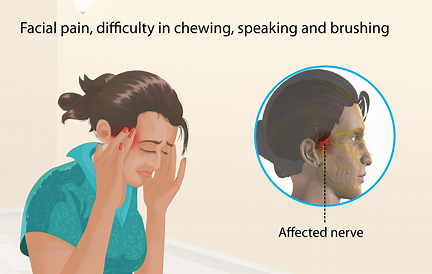
Oral facial pain includes but are not limited to the following:
- Temporomandibular Disorders:
Temporomandibular joint (TMJ) or jaw joint is where the jawbone connects to the skull at the side of the head. The free movement in the joint is sometimes affected, making it difficult or unable to open and close the jaw or chew foods. Symptoms include jaw pain, difficulty chewing, and clicking or grating sounds in the jaw joint. Based on the intensity of the condition, medication, surgery, physical therapy or a combination of all are used to treat the condition. - Myofascial Pain:
Myofascial face pain is a form of persistent, dull, aching pain originating from the face, neck, and / or jaw muscles. It can occur in patients with Temporomandibular Joint Disorder (TMD – see that section of our website), fibromyalgia, and as a primary problem following muscle strain or injury. - Muscle Spasm
- Headaches
- Migraine
- Oral Pain from teeth, gums, or bones
- Craniofacial Pain Syndromes like:
- Temporal Tendonitis
- Ernest Syndrome
- Hamular Bursitis
- Occipital Neuritis
- Arthritis (TMJ and Cervical)
- Trigeminal Neuralgia:
It is caused by the disruption of myelin present around the trigeminal nerve. Symptoms include facial pain, difficulty in chewing, speaking, and brushing. Treatment includes medication, and surgery. - Cervicalgia
- Anxiety
- Depression
- Fibromyalgia
- Muscle movement Disorders (Dystonias)
- Our goal is to quickly identify and diagnose facial pain for our patients!
- We perform a step by step comprehensive patient examination and evaluation including a maxillofacial neurological exam, a otic exam, and a thorough head and neck muscle examination
- Learn the two most important tools used to diagnose myofascial pain – one is free and the other one will cost you one penny each!
- Evaluation of the occlusion in relation to your orofacial pain.
- We will try to identify if facial pain is coming from the TMJ, neuralgia, ear, eyes, or facial muscles.
- We might suggest the use different chemotherapeutics (lidocaine, botulinum toxin, etc.) for differential diagnosis, pain management, and the best short-term and long-term successful therapeutic outcome
